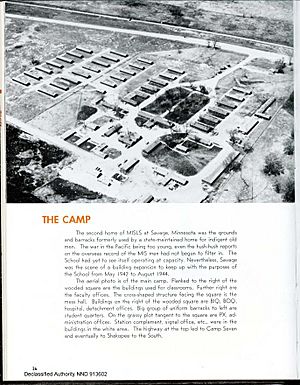Camp Savage facts for kids
Camp Savage was once a very important place during World War II. It was home to a special school for the U.S. Military Intelligence Service. This school taught military people and civilians the Japanese language.
Learning Japanese helped them in many ways during the war. They could talk to prisoners of war, understand captured documents, and help American soldiers communicate with Japanese civilians. The school first started in San Francisco but moved to Savage, Minnesota, in 1942. Later, it moved again to Fort Snelling in St. Paul, Minnesota.
Contents
The Story of Camp Savage
Why a Secret Language School Was Needed
Before World War II, relations between the United States and Japan became difficult. Some military officers who had lived in Japan realized something important. They knew the U.S. Army needed people who could understand and speak Japanese. This was crucial for gathering information and understanding what was happening.
It was hard to find many American soldiers who knew Japanese. So, the idea came up to use Japanese Americans, also called Nisei. These were American citizens whose families came from Japan. Many of them already knew the language. Two officers, Lt Col John Weckerling and Capt. Kai E. Rasmussen, were chosen to lead this new school. They found skilled Japanese-American soldiers, John F. Aiso and Arthur Kaneko, and two civilian teachers, Akira Oshida and Shigeya Kihara. These people became the first teachers at the Military Intelligence Service Language School (MISLS).
Starting Small and Moving On
The MISLS, first called the Fourth Army Intelligence School, began in November 1941. This was about a month before Japan attacked Pearl Harbor. It started with a small budget and its first class of 60 students in Presidio of San Francisco. In May 1942, 45 students finished their training.
After the attack on Pearl Harbor, many people in the U.S. felt angry towards Japanese people. Because of this, President Roosevelt issued Executive Order 9066. This order forced anyone with Japanese family, even a small amount, to leave the West Coast of the United States. This meant Japanese-American students couldn't train in California anymore.
Minnesota's Governor Harold Stassen offered a place called Camp Savage for the school. Camp Savage used to be a facility built by the Works Progress Administration. The school moved to Minnesota in June 1942. This new location had more space. It also helped solve the problem of training Japanese-American students in areas where they were not allowed to live.
Growing Big and Making a Difference
On June 1, 1942, the first class at Camp Savage began with 200 students and 18 teachers. The school grew quickly. By August 1944, it needed even more space. So, it moved to a larger place nearby called Fort Snelling.
After the war ended, the students who graduated from this language school did amazing things. They helped translate documents and worked as interpreters during trials for war crimes. They also played many important roles in helping Japan rebuild after the war.
In early 1946, the MISLS was at its busiest. It had 160 teachers and 3,000 students learning in over 125 classrooms. The last graduation ceremony at Fort Snelling was in June 1946. A total of 307 students graduated that day. This brought the total number of MISLS graduates to more than 6,000!
This special language program, which started with very little money, became the beginning of the Defense Language Institute. This institute now trains thousands of language experts who help the United States around the world.
Many Japanese-American soldiers who trained in Minnesota decided to stay there after the war. In 1940, only 51 people of Japanese heritage lived in Minnesota. Most of them worked on railroads. By 1950, that number had grown to 1,049 people. This shows how the school brought new communities to the state.
See also
- Japanese American internment
- Japanese language education in the United States



